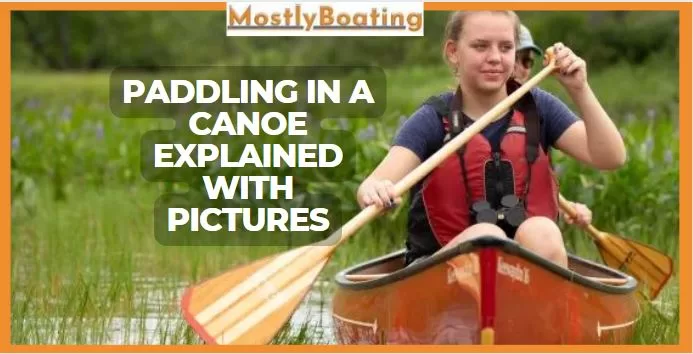Are you looking for a new adventure to add to your bucket list? Why not try paddling in a canoe? Canoeing is a great way to explore the outdoors and connect with nature.
Whether you’re paddling solo or with a partner, there are endless opportunities to discover new waterways and enjoy the beauty of the natural world.
From paddling in current to solo canoeing tips, there are many techniques and tricks to learn to make your canoeing experience even more enjoyable.
In this blog post, we’ll explore the canoeing world and provide tips and tricks to help you get started. So grab your paddle, and let’s dive in!
Key Takeaways On Paddling In A Canoe
Can a beginner easily paddle a canoe solo- A beginner can easily paddle a canoe solo by taking a course, watching expert tips, following step-by-step instructions, using recommended equipment, and adjusting their seating position.
How can I paddle a canoe (without risk of capsizing) – To avoid canoe capsizing, load the boat properly, keep your weight balanced, minimize movement, take lessons, paddle in groups, wear a canoe life jacket, and learn current navigation techniques.
Where to sit in a canoe while paddling- If paddling a canoe solo, the best position is either at the center point or just the back of the center (towards the stern) for optimal control in all conditions. Kneeling or sitting on the bow seat facing the stern is common.
Paddling Forward
- Maintain a low center of gravity
When paddling a canoe, it is important to maintain a low center of gravity to maintain balance and stability.
Keep your weight balanced over the canoe’s center and maintain three points of contact with the canoe to stabilize it on both sides with your hands while stepping into the center line of the canoe with your foot.
- Grip the paddle with one hand on top and the other a few feet down
To grip the paddle, put one hand on top of the handle’s end and use your other hand to grab a lower point on the handle. This grip gives you more control over the paddle and makes efficient strokes.
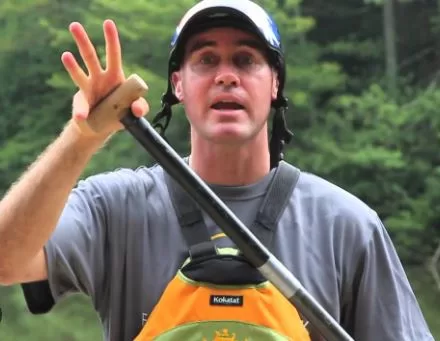
- Don’t let your belly go to jelly
Engaging your core muscles to maintain stability and power your strokes is important when paddling. Keep your core muscles active and engaged, and do not let your belly go to jelly.
- Reach forward with your paddle
To start paddling, reach forward with your paddle and submerge the paddle blade in the water. Turn the blade perpendicular to the boat and pull the paddle back towards you to propel the canoe forward.
- Pull the paddle back towards you
After submerging the paddle blade in the water, pull the paddle back towards you to propel the canoe forward. Use your back muscles and core muscles to power your strokes.
- Restart the paddling motion at your hip
After pulling the paddle back towards you, restart the paddling motion at your hip. This motion involves twisting at the torso so that your water-side shoulder and the paddle shift forward, then submerging the blade in the water again.
- Switch the side you paddle on every few strokes
Switch the side you paddle on every few strokes to maintain a straight course and avoid turning in one direction. This technique helps to balance the canoe and maintain a straight course.
As for canoe paddle length 52 and 60 inches is the recommended, therefore, you can paddle smoothly and at good pace, if yours canoe paddle ranger between this list.
Steering
When steering a canoe, several techniques and strokes can be used. Here are the different techniques and strokes, along with their functions and how to perform them:
- Paddle on one side continuously for gentle turns
The simplest way to turn a canoe is to paddle on one side continuously. Assuming you are sitting in the stern or center of the canoe, paddle as you normally would on one side to start turning in the opposite direction eventually. This technique is best used for making gentle turns.
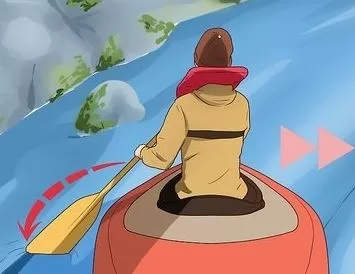
- Forward-Stroke For Straight Movement
The forward stroke is the basic stroke for propelling the canoe forward. Both paddlers should paddle on opposite sides of the canoe and match the cadence of the bow paddler’s strokes. The forward stroke maintains a straight course and moves the canoe forward.
- Use “J” strokes for the more controlled turn.
The J stroke is fundamental for maintaining a straight course while paddling. It involves a combination of the forward stroke and a slight twist of the wrist at the end to create a “J” shape with the paddle.
The J stroke provides gentle course correction and helps keep the canoe in the right direction. This stroke is best used for making controlled turns.
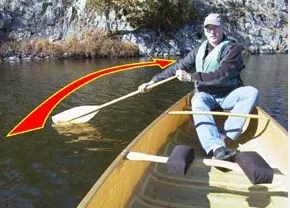
- Use large back sweeps for sharp turns
Large back sweeps are used for making sharp turns. The stern paddler can use a combination of the stern sweep and bow draw strokes to make a sharp turn. The bow paddler should communicate with the stern paddler about the desired direction and any obstacles.
- Alternatively, use draws for sharp turns
Draws are also used for making sharp turns. The bow draw is performed by placing the paddle blade in front of the bow and pulling the canoe towards the paddle.
The stern draw is performed by placing the paddle blade behind the stern and pulling the canoe towards the paddle. These strokes are useful for maneuvering in tight spaces or making precise canoe position adjustments.
- Sweep Stroke for Left and Right Turn
The sweep stroke is used for making wide turns. The stern sweep is performed by placing the paddle blade behind the canoe’s stern and sweeping it in a wide arc toward the bow.
The bow sweep is performed by placing the paddle blade before the bow and sweeping it in a wide arc toward the stern. These strokes are effective for making gradual turns and changing direction.
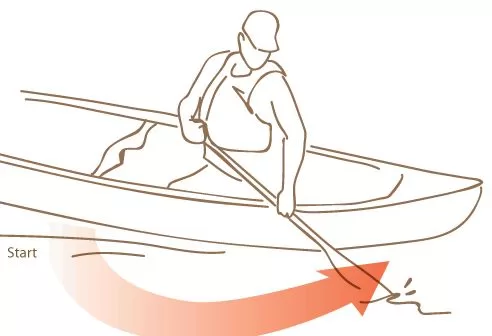
- Stopping a canoe
Both paddlers must paddle backward on the opposing side of the canoe to stop it. When stopping to paddle and any obstructions in the path, the bow paddler should communicate with the stern paddler.
There are two different shapes of a paddle, which can either be straight and bent shaft canoe paddle. A straight paddle is good for maneuverability at tight corners, while bent shaft paddle is good for cruising and longer trips.
How to Paddle A Two-Person Canoe (Tandem) – With Your Partner
Paddling a two-person canoe (Tandem Canoe) requires coordination and communication between the two paddlers. Here are some of the important steps you need to focus on:
Sit at opposite ends of the canoe
When paddling in tandem, it is important to sit at opposite ends of the canoe to maintain balance and stability. The bow paddler sits in the front of the canoe, while the stern paddler sits in the back. This sitting arrangement helps to keep the canoe “trimmed” and balanced in the water.

Let the bowman set the pace
The bow paddler sets the pace for the canoe. The stern paddler should match the cadence of the bow paddler’s strokes to maintain a consistent canoeing speed and direction.
The bow paddler should make smooth and consistent strokes to make it easier for the stern paddler to match the pace.
Let the sternman handle steering
The stern paddler is responsible for steering the canoe. The stern paddler can use a combination of different strokes to make turns and maneuver the canoe.
The bow paddler should communicate with the stern paddler about the desired direction and any obstacles.
Synchronize your side-switching to travel in a straight line.
When traveling forward, having both people paddle on opposite sides of the canoe generally gives the straightest result.
To make sure you don’t accidentally start paddling on the same side of the boat and cause it to turn, make sure to switch sides at the same time. Generally, the bow paddler calls out when to switch sides.
Be aware of differences in steering techniques for the bowman.
The bow paddler can use a variety of strokes to help steer the canoe, including the J-stroke, draw stroke, and pry stroke. The stern paddler should know these techniques and communicate with the bow paddler about the desired direction and any obstacles.
Forward Power
The forward stroke is the basic stroke for propelling the canoe forward. Both paddlers should paddle on opposite sides of the canoe and match the cadence of the bow paddler’s strokes. The forward stroke maintains a straight course and moves the canoe forward.
Slow Turn
The slow turn is used for making gradual turns. The stern paddler can use a combination of the stern sweep and bow draw strokes to make a slow turn. The bow paddler should communicate with the stern paddler about the desired direction and any obstacles.
Hard Turn
The hard turn is used for making sharp turns. The stern paddler can combine the goon stroke and stern sweep strokes to make a hard turn. The bow paddler should communicate with the stern paddler about the desired direction and any obstacles.
Stopping a canoe
To stop the canoe, both paddlers should paddle backwards on opposite sides of the canoe. The bow paddler should communicate with the stern paddler about when to stop paddling and any obstacles in the way.
Some people even use kayak paddle for canoeing, because they are more effective due to their double-blade design and increased length.
The difference in Canoe Paddling During Solo or Tandem Canoeing
| Aspect | Solo Canoeing | Tandem Canoeing |
| Canoe Size | Shorter, anywhere from 10-16 feet long | Generally 16-18 feet long |
| Seating | One seat that’s centred in the boat | A seat both in the bow and stern |
| Paddle Option | Single-blade paddles (traditional canoe paddles) and double-blade paddles (commonly used with kayaks) | Single-blade paddles |
| Stability | Can be less stable due to the weight distribution | Requires coordination between two paddlers |
| Maneuverability | Easier to control when you paddle alone | more stable due to the weight distribution |
| Ploughing Through Waves | Can send the bow knifing through big waves | Can stay drier in rough water |
| Paddling Technique | Can sit backwards on the bow seat and paddle the canoe “backwards” | Bow paddler mainly paddles forward, while the stern paddler paddles forward and steers |
Can You Paddle a Canoe Sideways and in reverse?
Yes, you can paddle a canoe sideways and in reverse. Here’s how to do it for solo and tandem canoeing:
Solo Canoeing:
Sideways Paddling: To paddle a canoe sideways, use the pry stroke. Place the paddle blade parallel to the side of the canoe and push the water away from the canoe.
This will move the canoe sideways. The pry stroke is useful for avoiding rocks, docking, or maneuvering in tight spots.
Reverse Paddling: When paddling a canoe, sit backwards on the bow seat and move the canoe “backwards.” Your weight may now be moved forward in the boat using this.
Just like paddling forward, but in reverse, it is paddling backwards. This method can be used to move backwards for a short while or to avoid anything farther down the line.
Tandem Canoeing:
Sideways Paddling: To paddle a tandem canoe sideways, both paddlers can use the pry stroke on opposite sides of the canoe.
Place the paddle blade parallel to the side of the canoe and push the water away from the canoe. This will move the canoe sideways. The pry stroke is useful for avoiding rocks, docking, or manoeuvring in tight spots.
Reverse Paddling: To paddle a tandem canoe in reverse, both paddlers can paddle backwards on opposite sides of the canoe.
This is similar to paddling forward but in reverse. The bow paddler should communicate with the stern paddler about when to start and stop paddling backwards.
What are different strokes and draws while canoe paddling, how they different?
J Stroke
The J stroke is fundamental for maintaining a straight course while paddling. It involves a combination of the forward stroke and a slight twist of the wrist at the end to create a “J” shape with the paddle.
The J stroke provides gentle course correction and helps keep the canoe in the right direction. This stroke is best used for maintaining a straight course while paddling solo or in the stern of a tandem canoe.
Goon Stroke
The goon stroke is a variation of the J stroke. It is a more aggressive and powerful stroke for quick turns or manoeuvring in tight spaces. It involves a stronger wrist twist at the stroke’s end to create a sharper turn. This stroke is best used for quick turns or manoeuvring in tight spaces.
Pry Stroke
The pry stroke moves the canoe sideways or away from an obstacle. It involves placing the paddle blade in the water parallel to the side of the canoe and pushing the water away from the canoe.
The pry stroke is useful for avoiding rocks, docking, or manoeuvring in tight spots. This stroke is best used for moving the canoe sideways or away from an obstacle.
Stern Sweep & Bow Sweep
The stern sweep and bow sweep strokes are used for making wide turns. The stern sweep is performed by placing the paddle blade behind the canoe’s stern and sweeping it in a wide arc towards the bow.
The bow sweep is performed by placing the paddle blade before the bow and sweeping it in a wide arc towards the stern. These strokes are effective for making gradual turns and changing direction. These strokes are best used for making gradual turns and changing direction.
Bow and Stern
The bow and stern draw strokes are used to move the canoe sideways towards the paddle. The bow draw is performed by placing the paddle blade in front of the bow and pulling the canoe towards the paddle.
The stern draw is performed by placing the paddle blade behind the stern and pulling the canoe towards the paddle. These strokes are useful for manoeuvring in tight spaces or making precise canoe position adjustments.
These strokes are best used for manoeuvring or making precise canoe position adjustments in tight spaces.
Draw Cross
The draw cross is a combination of the bow draw, forward stroke, and J stroke. It involves pulling the paddle through the water in a diagonal motion across the front of the canoe.
The draw cross is useful for maintaining a straight course while moving sideways or slightly adjusting the canoe’s position.
This stroke is best used to maintain a straight course while moving sideways or slightly adjusting the canoe’s position.
Bow Draw
The bow draw moves the canoe sideways towards the paddle while maintaining a straight course. It involves placing the paddle blade in front of the bow and pulling the canoe towards the paddle while keeping the paddle close to the canoe.
This stroke is best used for moving the canoe sideways towards the paddle while maintaining a straight course.
Stern and Bow Pry
The stern and bow pry strokes move the canoe sideways away from an obstacle. The stern pry is performed by placing the paddle blade behind the canoe’s stern and pushing the water away from the canoe.
The bow pry is performed by placing the paddle blade before the bow and pushing the water away from the canoe. These strokes are best used for moving the canoe sideways away from an obstacle.
Bow Reverse J Stroke
The bow paddler uses the bow reverse J stroke to steer the canoe in reverse. It is similar to the regular J stroke but performed in reverse.
The bow reverses J stroke helps the bow paddler maintain control and steer the canoe while paddling in reverse. This stroke is best used for steering the canoe in reverse.
C-Stroke
The C-stroke combines the bow draw, forward stroke, and J-stroke. It involves curvedly pulling the paddle through the water, creating a “C” shape.
The C-stroke is useful for maintaining a straight course while providing continuous propulsion. This stroke is best used for maintaining a straight course while providing continuous propulsion.
Where to sit while paddling; Kneel behind the center brace or rear seat? (During paddling a canoe solo)
- Kneeling behind the center brace:
Kneeling behind the center brace is a common position for solo canoeing. It helps to lower the center of gravity and provides better stability and control over the canoe. Kneeling also improves hip rotation and stroke power, benefiting longer paddling trips or canoe camping.
- Sitting on the rear seat:
Sitting on the rear seat is another option for solo canoeing. It provides a more comfortable and relaxed position for paddling, but it may provide less control and stability than kneeling. Sitting on the rear seat can benefit shorter paddling trips or those who prefer a more comfortable position.
Ultimately, the choice between kneeling behind the center brace or sitting on the rear seat depends on personal preference and the type of canoeing.

Kneeling provides better stability and control while sitting on the rear seat provides a more comfortable position. When choosing a position, it is important to consider the paddling conditions and the paddler’s skill level.
What are advance canoe paddling techniques/Strokes and how do I master them?
In addition to the basic canoe paddling techniques, several advanced canoe paddling techniques and strokes can help you become a better paddler.
Here are some of the unique paddling techniques other than the basic ones:
The Low Brace Turn:
The low brace turn is a technique for making quick turns while maintaining balance and stability in the canoe. It involves placing the paddle blade flat on the water and using it as a brace to turn the canoe.
To master the low brace turn, practice proper paddle grip, positioning in the canoe, and keeping your arms and shoulders relaxed.
The Cross Bow Draw:
The crossbow draw is a technique used for moving the canoe sideways towards the paddle while turning the canoe at the same time.
It involves placing the paddle blade in the water on the opposite side of the turn and pulling the canoe towards the paddle while turning it in the desired direction.
To master the crossbow draw, practice proper paddle grip, positioning in the canoe, and keeping the paddle close to the canoe while pulling the water towards you.
The Sculling Draw:
The sculling draw moves the canoe sideways towards the paddle while maintaining a straight course. It involves placing the paddle blade in the water and moving it back and forth in a sculling motion while pulling the canoe towards the paddle.
The C-Stroke:
To master the sculling draw, practice proper paddle grip, positioning in the canoe, and keeping the paddle close to the canoe while sculling the water back and forth.
The C-stroke is a technique used for maintaining a straight course while providing continuous propulsion. It involves curvedly pulling the paddle through the water, creating a “C” shape.
To master the C-stroke, practice proper paddle grip, positioning in the canoe, and keeping the paddle close to the canoe while pulling the water in a curved motion.
Items you will need for canoe paddling (solo and tandem)
| Optional Items | Compulsory Items |
| Dry Bag | Canoe |
| Sunscreen | Paddle |
| Hat | Whistle |
| Sunglasses | Personal Floatation Device |
| Insect Repellent | Bail Bucket or Binge Pump |
| Water Bottle | |
| First Aid Kit | |
| Map and Compass | |
| Rope |
Things you need to be aware of before and while paddling the canoe
Before and while paddling a canoe, there are several things you need to be aware of.
- Proper Paddle Grip:
Hold the paddle with both hands, placing one hand on the handle’s end and the other a few feet down. This grip allows for better control and power during paddling.
- Positioning in the Canoe:
Your knees should be slightly bent when you sit in the boat with your weight spread evenly. If paddling a tandem canoe solo, sit backward in the bow seat to move your weight slightly toward the middle. This helps with balance and control.
- Entering and Exiting the Canoe:
When entering the canoe, stabilize it on both sides with your hands while stepping into the centre line of the canoe with your foot. If entering from a dock, have your partner hold the canoe while you step in. When exiting, reverse the process. This ensures stability and prevents tipping.
- Forward and Backward Paddling:
The forward stroke is the basic stroke for propelling the canoe forward. Place the paddle in the water parallel and as close to the canoe as possible.
Hold the paddle out with your grip hand as far over the water as you can reach, tilt the paddle forward, and submerge the blade in the water. Pull the paddle back towards you, keeping it close to the canoe, and repeat the motion.
- Turning and Maneuvering:
You can use a combination of different strokes to make turns. The J-stroke is commonly used for maintaining a straight course while turning. It involves a slight twist of the wrist at the end of the stroke to create a “J” shape with the paddle.
The sweep stroke is used for making wide turns, and the draw stroke is used for moving the canoe sideways toward the paddle. The pry stroke moves the canoe sideways away from an obstacle.
- Safety Precautions:
Always use a personal flotation device (PFD) or life jacket while paddling. Be aware of the weather conditions and water currents before heading out.
Bring essential safety equipment such as a whistle, a throw rope, and a first aid kit. It is also important to inform someone about your paddling plans and estimated return time.
- Practice and Experience:
Paddling a canoe effectively requires practice and experience. Take the time to familiarize yourself with the different strokes and techniques.
Start in calm and controlled environments before venturing into more challenging waters. Consider taking a canoeing course or seeking guidance from experienced paddlers to improve your skills.
Are the paddling methods the same for all waterways?
Canoe paddling methods can vary depending on the type of waterway you are paddling in.
- Paddling in Current:
Specific techniques can be used to navigate effectively when paddling in current. These techniques include ferrying, eddy turns, and peel-outs.
Ferrying involves angling the canoe to move across the current, while eddy turns are used to enter or exit eddies (calm areas behind obstacles).
Peel-outs are used to exit eddies and re-enter the current smoothly. These techniques are useful for paddling rivers and other waterways with strong currents.
- Paddling on Rivers:
Paddling on rivers requires adapting to the flow and obstacles. It is important to protect yourself and the canoe from hazards and then relocate to a safer area.
The logistics for maximum efficiency can vary depending on the specific river and its characteristics. Paddling on rivers requires a combination of basic strokes and specialized techniques to navigate effectively.
- Paddling on Lakes:
Paddling on lakes requires a combination of basic strokes and specialized techniques to navigate effectively.
The J-stroke is particularly useful for maintaining a straight course, while the sweep stroke makes gradual turns. Paddling on lakes also requires adapting to wind and waves, which can affect the direction and stability of the canoe.
- Paddling in Open Water:
Paddling in open water, such as the ocean, requires specialized techniques to navigate effectively. These techniques include bracing, which involves using the paddle to stabilize the canoe in rough water, and surfing, which involves riding waves to move the canoe forward.
Paddling in open water also requires adapting to wind and waves, which can affect the direction and stability of the canoe.
- Paddling in Tandem:
When paddling in a canoe (two-person), it is important to distribute body weight properly. The bow person mainly paddles forward, while the stern person paddles forward and steers.
The bow person can use draw or pry strokes to save the boat from hitting obstacles or to pull the canoe into a dock. The stern person can use the sweep and J-stroke to help steer the canoe.
These techniques are useful for paddling various waterways, including rivers, lakes, and open water.
Single Blade Paddle or Double-Blade Canoe – Which one Is Recommended?
When choosing between a single-blade paddle and a double-bladed paddle for canoeing, there are several factors to consider.
Single-Blade Paddle:
- A single-blade paddle is a traditional paddle used for canoeing.
- It is shorter than a double-bladed paddle and easier to handle, making it ideal for maneuvering in tight spaces.
- It is more versatile and allows for a wider range of strokes and draws, making it useful for navigating different water conditions and making precise adjustments to the canoe’s position.
- It requires more skill and technique to use effectively, but it can be more efficient and satisfying once mastered.
- It is recommended for solo canoeing, as it provides better control and balance for the paddler.
Double-Bladed Paddle:
- A double-bladed paddle is typically used for kayaking but can also be used for canoeing.
- It is longer than a single-blade paddle and allows for a higher stroke cadence, making it ideal for long-distance touring and open water crossings.
- It is easier for beginners and requires less skill and technique. It is recommended for tandem canoeing, providing more power and speed for the paddlers.
- It can be useful in shallow water and windy conditions, allowing quick correction strokes and a higher stroke cadence.
A single-blade paddle is more versatile and allows for a wider range of strokes and draws, while a double-bladed paddle is easier to use and allows for a higher stroke cadence.
The choice between a single-blade and a double-bladed paddle depends on personal preference, the type of canoeing, and the paddling conditions.
A single-blade paddle is recommended for better control and balance for solo canoeing. For tandem canoeing, a double-bladed paddle is recommended for more power and speed.
FAQs – Paddling in a canoe
How to paddle a canoe fast?
To paddle a canoe fast, use proper technique with a combination of forward, J, and sweep strokes. Sit in the right position, engage your core muscles, practice in current, and wear appropriate gear for safety.
What are some effective methods for coordinating paddling strokes with a partner in a tandem canoe?
To coordinate paddling strokes in a tandem canoe, paddle on opposite sides, sync your strokes, communicate and switch sides, and learn the J-stroke. These methods help maintain balance, efficiency, and effective navigation with your partner.
Does A Canoe Use A Paddle Or An Oar?
A canoe uses a paddle, not an oar. A paddle has one blade, while an oar has two blades. Paddles are used for paddling, while oars are used for rowing. Canoe paddles differ from kayak paddles.
How do I adjust my paddling technique when encountering different water conditions, such as calm lakes versus flowing rivers?
To adjust your paddling technique for different water conditions, practice in various conditions, experiment with wind directions, use your top hand to push and pull the paddle in choppy water like whitewater, maintain proper posture and positioning, and seek expert guidance for instruction and skill improvement.
How can I overcome common challenges, like fatigue or blisters, during extended canoe trips?
To overcome challenges during extended canoe trips, prevent blisters by wearing gloves or other canoeing accessories and proper paddling techniques, minimize fatigue by taking breaks and adjusting your seating position, and seek expert guidance to improve your paddling skills.
Can you recommend specific exercises or drills to improve my paddling technique and build upper body strength?
Try exercises like pull-ups, hover push-ups, arm raises, and arm circles to improve your paddling technique and build upper body strength for canoeing. Mimic paddling movements in the gym and seek expert guidance for personalized instruction.

Jack Bennett, a passionate pedal boating enthusiast, and marine engineer by day, is here to share my knowledge and love for this exciting sport with you all. Happy Boating!
